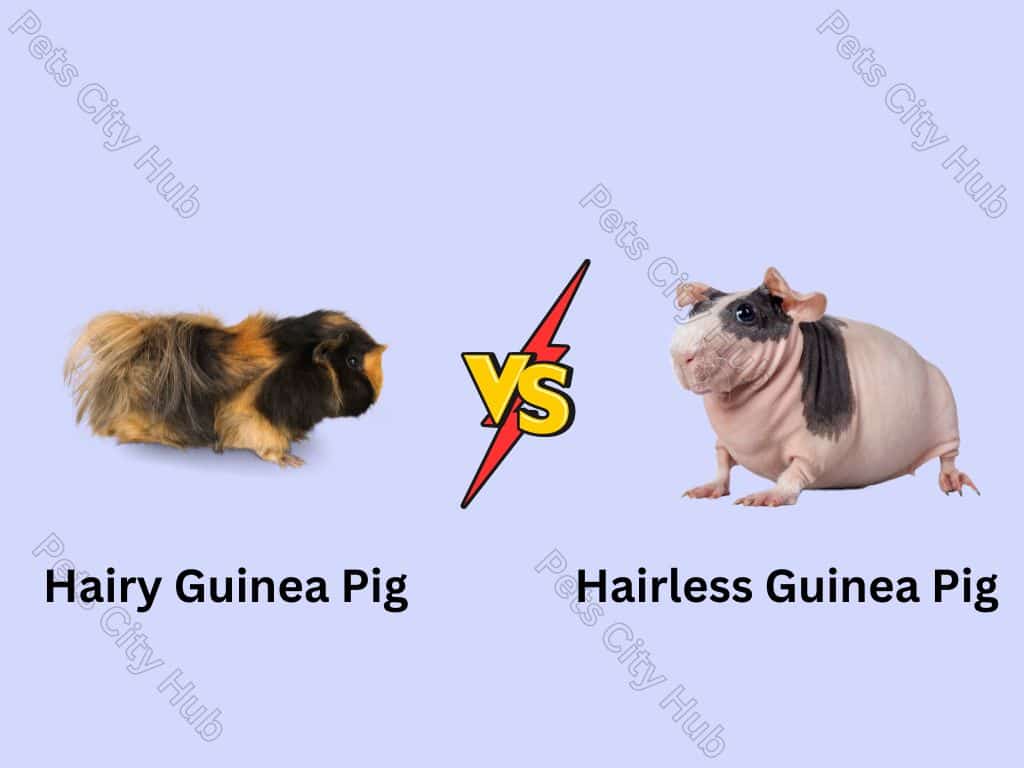Hairless guinea pigs, often referred to as “skinny pigs” are captivating creatures known for their unique appearance. Unlike their furry counterparts, they have little to no fur. Their distinct looks have helped them to gain a spotlight in the world of guinea pigs.
But lack of fur not only gives them a distinctive appearance but also makes them more vulnerable to certain health issues and environmental factors.
So as a responsible owner, you should know how to take care of them, including their health issues, diet, and other related factors.
Well, this article is right about those facts. You will get here the hairless guinea pig’s health and care, dietary requirements, suitable housing and environmental considerations, along with other related information.
Overview of Hairless Guinea Pigs
There are two kinds of hairless guinea pigs, the Baldwins guinea pigs and the skinny pigs.
The Baldwin guinea pigs, sometimes called hippo guinea pigs, are born with fur that falls out within the first few months of their birth and they become furless. Baldwin guinea pigs are a bit larger than skinny pigs, and their ears are droopier. Besides, Baldwin’s skin has a rubbery texture. They originated from a genetic mutation and were first recognized in California.
On the other hand, skinny guinea pigs are born without hair, though they develop small patches of hair on their face and feet as they age. Their skin can also have pigment patterns. Skinny guinea pigs originated from a genetic mutation in a lab at Montreal’s Armand Frappier Institute in Canada in 1978.
But don’t be afraid as skinny guinea pigs obtain their bald-skin genetic feature from the lab. Movies might make us think lab-created creatures are monsters and zombies. Infect, skinny guinea pigs are entirely harmless, safe, and innocent animals.

Hairy Guinea Pig vs Hairless Guinea Pig: key Difference
The main difference between hairy and hairless guinea pigs is their fur. But there are also some other differences. Below I am describing those.
- Hairless guinea pigs tend to eat more than hairy guinea pigs because they have a higher metabolism.
- Hairless guinea pigs even pee and poop more than hairy guinea pigs because they eat more, as I told you above.
- Hairless guinea pigs are more sensitive to temperature.
- Due to their lack of fur, they are more prone to skin issues than their hairy counterpart.
- Generally, hairless guinea pigs are more active and energetic, possibly due to their higher metabolism which helps them maintain body heat.
Housing and Environment for Hairless Guinea Pigs
There is not much difference between the hairy guinea pigs and hairless guinea pigs living environments. Since hairless guinea pigs have no protective far, they are sensitive to temperature and direct sunlight.
To ensure their comfort, keep their living environment between 72°F to 75°F (21°C to 24°C) and out of direct sunlight.
And other aspects of their living environment/cage should be the same as for hairy guinea pigs.
For example:
- Their cage should be well-ventilated.
- To prevent foot injuries, avoid wire flooring and use plastic or paper on the cage floor for your guinea pigs. You can also use the C & C cage.
- The cage should offer your guinea pigs ample space for play and exercise, with minimum dimensions of 50 inches in length, 24 inches in width, and 18 inches in height.
- Give them a hiding place, like a box, where they can sleep and take refuge when they feel scared.
- The cage should be robust enough to keep them safe from predators like dogs and cats.
Hairless Guinea Pigs Diet
There isn’t a dietary difference between hairy and hairless guinea pigs, but hairless guinea pigs tend to eat more than their hairy counterparts. So, make sure your hairless friend receives enough food to thrive.
I am not discussing guinea pigs’ dietary requirements here, as it would make this content too lengthy and possibly boring. If you want to learn just about their dietary needs, please visit this article, where we have focused solely on guinea pigs’ dietary requirements.
Grooming and Cleaning for Hairless Guinea Pigs
Typically, guinea pigs have low grooming requirements, but hairless guinea pigs need slightly more grooming than hairy guinea pigs.
Due to their bald skin, hairless guinea pigs can develop dry skin, which can lead to infection. If your hairless guinea pig’s skin becomes very dry, apply a small amount of coconut oil or it is better to consult with a vet about which moisturizer to use.
Besides, a hairless guinea pig doesn’t need bath unless it becomes very dirty. Don’t forget to trim their nails once a month, as this is very important for hairless guinea pigs. Since they don’t have protective fur, even a gentle scratch from another guinea pig can cause skin injuries.
Additionally, as mentioned earlier, hairless guinea pigs eat more, as a result, they also poop and pee more. Therefore, you will need to clean their cage more often, ideally 2-3 times per week.
Health Issues in Hairless Guinea Pigs
- Dental problem
- Respiratory infection
- Gastrointestinal issues
Besides, the normal lifespan of a hairless guinea pig is shorter than hairy guinea pig, typically ranging from 5 to 7 years.
FAQs About Hairless Guinea Pigs
Can hairless guinea pigs live with hairy guinea pigs?
Yes, hairless guinea pigs can live with hairy guinea pigs, but it’s important to introduce them slowly to establish a bond first.
Is it difficult to care for hairless guinea pigs?
No, hairless guinea pigs aren’t hard to take care of. They just need a little bit more care than hairy guinea pigs.
Are hairless guinea pigs less allergic?
Yes, they are. Some people with allergies may find hairless guinea pigs to be less allergenic than hairy ones because they lack fur.














Comments are closed.